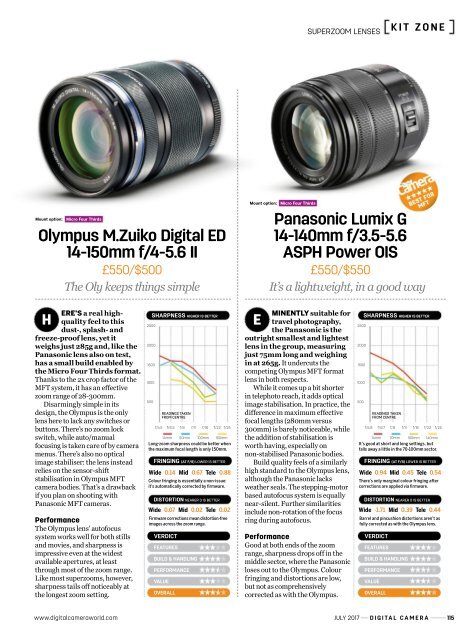Digital_Camera_World_Issue_192_July_2017
You also want an ePaper? Increase the reach of your titles
YUMPU automatically turns print PDFs into web optimized ePapers that Google loves.
SUPERZOOM LEnSES<br />
KIT Zone<br />
Mount option: Micro Four Thirds<br />
olympus m.Zuiko digital ed<br />
14-150mm f/4-5.6 ii<br />
£550/$500<br />
The Oly keeps things simple<br />
Mount option:<br />
Micro Four Thirds<br />
Panasonic lumix g<br />
14-140mm f/3.5-5.6<br />
asPh Power ois<br />
£550/$550<br />
It’s a lightweight, in a good way<br />
H<br />
ere’s a real highquality<br />
feel to this<br />
dust-, splash- and<br />
freeze-proof lens, yet it<br />
weighs just 285g and, like the<br />
Panasonic lens also on test,<br />
has a small build enabled by<br />
the Micro Four Thirds format.<br />
Thanks to the 2x crop factor of the<br />
MFT system, it has an effective<br />
zoom range of 28-300mm.<br />
Disarmingly simple in its<br />
design, the Olympus is the only<br />
lens here to lack any switches or<br />
buttons. There’s no zoom lock<br />
switch, while auto/manual<br />
focusing is taken care of by camera<br />
menus. There’s also no optical<br />
image stabiliser: the lens instead<br />
relies on the sensor-shift<br />
stabilisation in Olympus MFT<br />
camera bodies. That’s a drawback<br />
if you plan on shooting with<br />
Panasonic MFT cameras.<br />
Performance<br />
The Olympus lens’ autofocus<br />
system works well for both stills<br />
and movies, and sharpness is<br />
impressive even at the widest<br />
available apertures, at least<br />
through most of the zoom range.<br />
Like most superzooms, however,<br />
sharpness tails off noticeably at<br />
the longest zoom setting.<br />
2500<br />
2000<br />
1500<br />
1000<br />
500<br />
sharPness higher is Better<br />
f/4.5<br />
readingS taken<br />
from centre<br />
Verdict<br />
FeatUres<br />
BUild & handling<br />
PerFormance<br />
ValUe<br />
f/6.5<br />
oVerall<br />
f/8 f/11 f/16 f/22 f/25<br />
14mm 50mm 100mm 150mm<br />
Long-zoom sharpness could be better when<br />
the maximum focal length is only 150mm.<br />
Fringing (at F/8) lower iS better<br />
Wide 0.14 Mid 0.67 Tele 0.88<br />
Colour fringing is essentially a non-issue:<br />
it’s automatically corrected by firmware.<br />
distortion nearer 0 iS better<br />
Wide 0.07 Mid 0.02 Tele 0.02<br />
Firmware corrections mean distortion-free<br />
images across the zoom range.<br />
E<br />
minently suitable for<br />
travel photography,<br />
the Panasonic is the<br />
outright smallest and lightest<br />
lens in the group, measuring<br />
just 75mm long and weighing<br />
in at 265g. It undercuts the<br />
competing Olympus MFT format<br />
lens in both respects.<br />
While it comes up a bit shorter<br />
in telephoto reach, it adds optical<br />
image stabilisation. In practice, the<br />
difference in maximum effective<br />
focal lengths (280mm versus<br />
300mm) is barely noticeable, while<br />
the addition of stabilisation is<br />
worth having, especially on<br />
non-stabilised Panasonic bodies.<br />
Build quality feels of a similarly<br />
high standard to the Olympus lens,<br />
although the Panasonic lacks<br />
weather seals. The stepping-motor<br />
based autofocus system is equally<br />
near-silent. Further similarities<br />
include non-rotation of the focus<br />
ring during autofocus.<br />
Performance<br />
Good at both ends of the zoom<br />
range, sharpness drops off in the<br />
middle sector, where the Panasonic<br />
loses out to the Olympus. Colour<br />
fringing and distortions are low,<br />
but not as comprehensively<br />
corrected as with the Olympus.<br />
2500<br />
2000<br />
1500<br />
1000<br />
500<br />
sharPness higher is Better<br />
f/4.8<br />
readingS taken<br />
from centre<br />
14mm 70mm 100mm 140mm<br />
It’s good at short and long settings, but<br />
falls away a little in the 70-100mm sector.<br />
Fringing (at F/8) lower iS better<br />
Wide 0.94 Mid 0.45 Tele 0.54<br />
There’s only marginal colour fringing after<br />
corrections are applied via firmware.<br />
distortion nearer 0 iS better<br />
Wide -1.71 Mid 0.39 Tele 0.44<br />
Barrel and pincushion distortions aren’t as<br />
fully corrected as with the Olympus lens.<br />
Verdict<br />
FeatUres<br />
BUild & handling<br />
PerFormance<br />
ValUe<br />
f/6.7<br />
oVerall<br />
f/8 f/11 f/16 f/22 f/25<br />
www.digitalcameraworld.com JULY <strong>2017</strong> digital camera 115


















